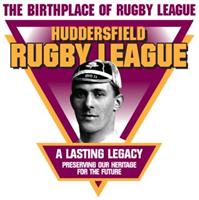Fartown
Sincere thanks to David Gronow for permission to publish the following article and photographs.
There are few physical reminders these days of the importance of a venue which once played host to rugby league International and Test matches and County Cup Finals.
The ground was originally known as the St John's Ground, after Huddersfield St John's Cricket Club who became its original occupants in 1868.
In 1875 St John's Cricket Club merged with Huddersfield Athletic Club to form the Huddersfield Cricket and Athletic Club.
Although the athletic club had formed a rugby football section in 1866, Fartown was initially used for athletics festivals.
Alterations made in the summer of 1878 meant that rugby could begin at the start of the 1878/79 season with the visit of Manchester Rangers on 2 November.
The venue quickly became synonymous with Huddersfield RLFC - the Fartowners.In 1882, a crowd of 10,000 turned up to see an FA Cup semi-final between Sheffield Wednesday and Blackburn Rovers, organised as part of an attempt by the Football Association to promote the game of soccer in what was, at the time, a predominantly rugby focused town.
Blackburn Rovers drew 0-0 with Sheffield Wednesday, forcing a replay at Fallowfield in Manchester - Blackburn eventually won 5-1, and went on to lose 1-0 in the final to Old Etonians.
The decision to move changing facilities to the pavilion, allied to development work at the ground, saw Fartown become a regular venue for Northern Union matches, including three Challenge Cup finals (1908 and the two 1911 replayed finals), three championship finals (1907, 1936 and 1979) and the Third Test between Great Britain and Australia in 1937.
The attendance record of 35,136 was set on 19 April 1947 for a Challenge Cup semi-final between Leeds and Wakefield Trinity, and three years later on 4 March 1950, a Huddersfield club record crowd of 32,912 saw Huddersfield play Wigan in a league match.
On 11 August, 1943 an exhibition baseball game was staged between two teams of American soldiers which attracted 2,400 curious spectators.
The 1980s saw the stadium decline rapidly as Huddersfield RLFC struggled to pull in spectators.
It was a constant battle to keep the old ground alive especially after the Bradford City fire in 1985.
By the time of the Valley Parade tragedy, Fartown had been renamed Arena 84 and the team Huddersfield Barracudas by local businessman John Bailey, who had taken over controlling interest in the grounds, club and pavilion, however, crowds continued to stay away with the ground falling into terminal decline.
The main stand was closed due to storm damage in 1986, with a new board of directors taking over in 1989 when much needed financial resources were injected into the club.
As well as beginning to improve the playing staff, the new owners also carried out a considerable amount of work on the Fartown stadium and by the end of the 1989/90 season significant progress was being made.
Not long after, Huddersfield Rugby League Club were forced to switch their home matches to Huddersfield Town’s Leeds Road ground in 1992 at the behest of the local authority before moving to the then purpose-built McAlpine ( now the Galpharm) Stadium two years later.
The JCB’s came in to rip out the terracing and knock down the grandstand of the old ground - 100 years of history destroyed in a matter of moments.
Fartown is still used in a minor rugby capacity - Pennine League club St Josephs using it for their home matches.
For the people of Huddersfield, Fartown came to symbolise not just the rugby club’s spiritual home, but the club itself, and while Huddersfield are now recognised as ’Giants’, the cry of ’Fartown, Fartown’ remains the norm at Super League matches.
As the old stadium has fallen into decline, Fartown has become a state of mind.
|
Huddersfield v Wigan April 1953Huddersfield take on Wigan at Fartown, 18 April 1953 |

DemolitionThe final stages of demolition and the departure from Fartown - Huddersfield's last professional game was against Ryedale York in a Yorkshire Cup Preliminary Round tie on 23 August 1992. |

FartownThe traditional home of Huddersfield Rugby League Football Club. |





